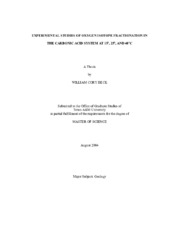| dc.description.abstract | In light of recent studies that show oxygen isotope fractionation in carbonate minerals to be a function of HCO3 2-; and CO3 2- concentrations, the oxygen isotope fractionation and exchange between water and components of the carbonic acid system (HCO3 2-, CO3 2-, and CO2(aq)) were investigated at 15, 25, and 40 (degrees)C. To investigate oxygen isotope exchange between HCO3 2-, CO3 -2, and H2O, NaHCO3 solutions were prepared and the pH was adjusted over a range of 2 to 12 by the addition of small amounts of HCl or NaOH. After thermal, chemical, and isotopic equilibrium was attained, BaCl2 was added to the NaHCO3 solutions. This resulted in immediate BaCO3 precipitation; thus, recording the isotopic composition of the dissolved inorganic carbon. Data from experiments at 15, 25, and 40 (degrees)C (1 atm) show that the oxygen isotope fractionation between HCO3 2-; and H2O as a function of temperature is governed by the equation:
1000 ;HCO3--H2O = 2.66 + 0.05(106T-2) + 1.18 + 0.52.
where is the fractionation factor and T is in kelvins. The temperature dependence of oxygen isotope fractionation between CO32 and H2O is
1000 CO32--H2O = 2.28 + 0.03(106T-2) - 1.50 + 0.29.
The oxygen isotope fractionation between CO2(aq) and H2O was investigated by acid stripping CO2(aq) from low pH solutions; these data yield the following equation:
1000 CO2(aq)-H2O = 2.52 + 0.03(106T-2) + 12.12 + 0.33.
The kinetics of oxygen isotope exchange were also investigated. The half-times for exchange between HCO3- and H2O were 3.6, 1.4, and 0.25 h at 15, 25, and 40 (degrees)C, respectively. The half-times for exchange between CO2 and H2O were 1200, 170, and 41 h at 15, 25, and 40 (degrees) C, respectively. These results show that the 18O of the total dissolved inorganic carbon species can vary as much as 17 at a constant temperature. This could result in temperature independent variations in the 18O of precipitated carbonate minerals, especially in systems that are not chemically buffered. | en |


